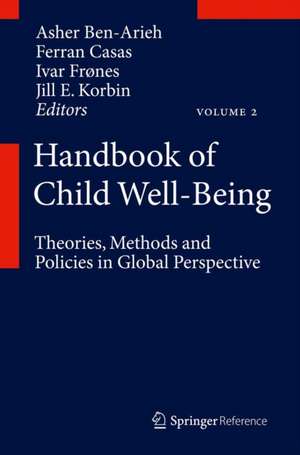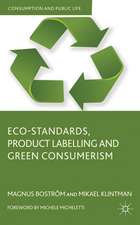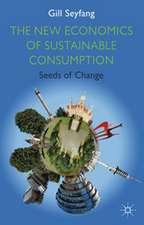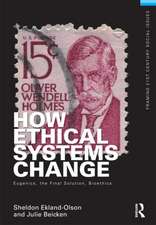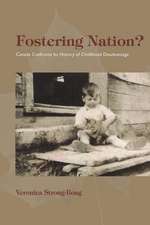Handbook of Child Well-Being: Theories, Methods and Policies in Global Perspective
Editat de Asher Ben-Arieh, Ferran Casas, Ivar Frønes, Jill E. Korbinen Limba Engleză Hardback – 7 oct 2013
Preț: 11153.49 lei
Preț vechi: 11740.51 lei
-5% Nou
Puncte Express: 16730
Preț estimativ în valută:
2134.16€ • 2234.27$ • 1765.92£
2134.16€ • 2234.27$ • 1765.92£
Carte disponibilă
Livrare economică 17-31 martie
Preluare comenzi: 021 569.72.76
Specificații
ISBN-13: 9789048190621
ISBN-10: 9048190622
Pagini: 3440
Ilustrații: XXXV, 3258 p. 142 illus., 76 illus. in color. In 5 volumes, not available separately.
Dimensiuni: 155 x 235 x 205 mm
Greutate: 5.97 kg
Ediția:2014
Editura: SPRINGER NETHERLANDS
Colecția Springer
Locul publicării:Dordrecht, Netherlands
ISBN-10: 9048190622
Pagini: 3440
Ilustrații: XXXV, 3258 p. 142 illus., 76 illus. in color. In 5 volumes, not available separately.
Dimensiuni: 155 x 235 x 205 mm
Greutate: 5.97 kg
Ediția:2014
Editura: SPRINGER NETHERLANDS
Colecția Springer
Locul publicării:Dordrecht, Netherlands
Public țintă
ResearchCuprins
Volume 1.- Chapter 1: Multifaceted Concept of Child Well-Being; Asher Ben-Arieh, Ferran Casas, Ivar Frønes, and Jill E. Korbin.- Section I: Multiple Perspectives on Child Well-Being.- Chapter 2: History of Children's Well-Being; Bengt Sandin.- Chapter 3: Culture, Context, and Child Well-Being; Thomas S. Weisner.- Chapter 4: Children, Gender, and Issues of Well-Being; Harriet Bjerrum Nielsen and Barrie Thorne.- Chapter 5: Childhood and Intergenerationality: Toward an Intergenerational Perspective on Child Well-Being; Leena Alanen.- Section II: Multiple Approaches to Child Well-Being.- Chapter 6: Child Well-Being: A Philosophical Perspective; Alexander Bagattini.- Chapter 7: Child Well-Being: Children's Rights Perspective; Jaap E. Doek.- Chapter 8: Neuroscience and Child Well-Being; Adeline Jabès and Charles A. Nelson.- Chapter 9: Educational Science and Child Well-Being; Sabine Andresen.- Chapter 10: Geographies of Children's Well-Being: in, of, and for Place; John H. McKendrick.- Chapter 11: Child Healthcare and Child Well-Being: From the Past to the Future; Christopher Greeley and Howard Dubowitz.- Chapter 12: Public Health Aspects of Child Well-Being; Sally Brinkman and Fiona Stanley.- Chapter 13: Well-Being of Children: A Criminologic Perspective; Mimi Ajzenstadt.- Chapter 14: Economics of Child Well-Being; Gabriella Conti and James J. Heckman.- Chapter 15: Social Work and Child Well-Being; Sheila B. Kamerman and Shirley Gatenio-Gabel.- Chapter 16: Children's Well-Being and Politics; Jo Moran-Ellis, Anna Bandt, and Heinz Sünker.- Chapter 17: Mediated Well-Being from the Perspective of Media and Communication Studies; Divina Frau-Meigs.- Chapter 18: Child Well-Being: Anthropological Perspectives; Edward G. J. Stevenson and Carol M. Worthman.- Chapter 19: Social Psychology and Child Well-Being; Ferran Casas, Mònica González, and Dolors Navarro.- Chapter 20: Psychology of Child Well-Being; Arne Holte, Margaret M. Barry, Mona Bekkhus, Anne Inger Helmen Borge, LucyBowes, Ferran Casas, Oddgeir Friborg, Bjørn Grinde, Bruce Headey, Thomas Jozefiak, Ratib Lekhal, Nic Marks, Ruud Muffels, Ragnhild Bang Nes, Espen Røysamb, Jens C. Thimm, Svenn Torgersen, Gisela Trommsdorff, Ruut Veenhoven, Joar Vittersø, Trine Waaktaar, Gert G. Wagner, Catharina Elisabeth Arfwedson Wang, Bente Wold, and Henrik Daae Zachrisson.-
Volume 2.- Section III: Theoretical Approaches to Child Well-Being.- Chapter 21: Understanding the Well-Being of Children and Adolescents Through Homeostatic Theory; Robert A. Cummins.- Chapter 22: Sociology: Societal Structure, Development of Childhood, and the Well-Being of Children; Jens Qvortrup.- Chapter 23: Children's Well-Being and Interpretive Reproduction; William A. Corsaro.- Chapter 24: Capability Approach as a Framework for Research on Children's Well-Being; Susann Fegter and Martina Richter.- Chapter 25: Socialization and Childhood in Sociological Theorizing; Lourdes Gaitán.- Section IV: Children’s Activities and Well-Being.- Chapter 26: Schooling and Children's Subjective Well-Being; E. Scott Huebner, Kimberly J. Hills, Xu Jiang, Rachel F. Long, Ryan Kelly, and Michael D. Lyons.- Chapter 27: Children's Work; Michael Bourdillon.- Chapter 28: After-School Activities and Leisure Education; Jaume Trilla, Ana Ayuste, and Ingrid Agud.- Chapter 29: Play and Well-Being in Children's Life; Jan Van Gils.- Chapter 30: Sport, Children, and Well-Being; Yngvar Ommundsen, Knut Løndal, and Sigmund Loland.- Chapter 31: Artistic Activity and Child Well-Being in Early Schooling: Revisiting the Narratives; Jolyn Blank.- Chapter 32: Civic Engagement and Child and Adolescent Well-Being; Daniel Hart, Kyle Matsuba, and Robert Atkins.- Chapter 33: State of the Field: Youth Community Service in the USA; Edward Metz.- Chapter 34: Time Use, Inequality, and Child Well-Being; Sara Raley.- Section V: Arts, Creativity and Child Well-Being.- Chapter 35: Images of Child Well-Being in the Arts; Ellen Handler Spitz.- Chapter 36: Role of Art and Creativity in Child Culture and Socialization; Khin Yee Lo and Koji Matsunobu.- Chapter 37: Imagination, Play, and the Role of Performing Arts in the Well-Being of Children; Philip E. Silvey.- Section VI: Spirituality and Religion.- Chapter 38: Relation of Spiritual Development to Youth Health and Well-Being: Evidence from a Global Study; Peter C. Scales, Amy K. Syvertsen, Peter L. Benson, Eugene C. Roehlkepartain, and Arturo Sesma, Jr..- Chapter 39: Religion and Child Well-Being; George W. Holden and Paul Alan Williamson.- Chapter 40: Religion, Spirituality, and Child Well-Being; Kurt Bangert.- Chapter 41: Islamic Education and Youth Well-Being in Muslim Countries, with a Specific Reference to Algeria; Habib Tiliouine.-
Volume 3.- Section VII: An Ecological Perspective on Child Well-Being.- Chapter 42: Family and Child Well-Being; Cigdem Kagitcibasi.- Chapter 43: Effects of School on the Well-Being of Children and Adolescents; Francisco Juan Garcı´a Bacete, Ghislaine Marande Perrin, Barry H. Schneider, and Celine Blanchard.- Chapter 44: Community and Place-Based Understanding of Child Well-Being; Claudia J. Coulton and James C. Spilsbury.- Chapter 45: Children's Social Networks and Well-Being; Deborah Belle and Joyce Benenson.- Chapter 46: Ecological Perspective on Child Well-Being; James Garbarino.- Section VIII: Economy/Material Well-Being.- Chapter 47: Poverty and Social Exclusion; Gerry Redmond.- Chapter 48: Well-Being and Children in a Consumer Society; Ragnhild Brusdal and Ivar Frønes.- Chapter 49: Children's Material Living Standards in Rich Countries; Gill Main and Kirsten Besemer.- Chapter 50: Child Costs; Bruce Bradbury.- Chapter 51: Child Labor and Children's Economic Contributions; Scott Lyon and Furio Camillo Rosati.- Chapter 52: Childhood and Inequalities: Generational Distributive Justice and Disparities; Helmut Wintersberger.- Chapter 53: Economics of Child Well-Being: Measuring Effects of Child Welfare Interventions; Anna Aizer and Joseph J. Doyle, Jr..- Section IX: Life Course and Child Well-Being.- Chapter 54: Infancy and Well-Being; Heidi Keller.- Chapter 55: Early Childhood: Dimensions and Contexts of Development and Well-Being; Elizabeth Fernandez.- Chapter 56: Developmental Assets and the Promotion of Well-Being in Middle Childhood; Peter C. Scales.- Chapter 57: Child Well-Being and the Life Course; Richard A. Settersten, Jr., Megan M. McClelland, and Alicia Miao.- Chapter 58: Adolescence and Well-Being; Rita Žukauskiene.- Chapter 59: Monitoring the Health and Well-Being of Developing Children in Changing Contexts: A Framework for Action; Bonnie Leadbeater, Wayne Mitic, and Michael Egilson.- Chapter 60: Transition to Adulthood; Janel Benson.- Section X: Interpersonal Relations.- Chapter 61: Allomothers and Child Well-Being; Courtney L. Meehan.- Chapter 62: Sibling Relationships and Children's Social Well-Being; K. Ripoll-Núñez and Sonia Carrillo.- Chapter 63: The Role of Peers in Children's Lives and Their Contribution to Child Well-Being: Theory and Research; Daphna Gross-Manos.- Chapter 64: Children's Social and Emotional Relationships and Well-Being: From the Perspective of the Child; Colette McAuley and Wendy Rose.- Chapter 65: Children as Caregivers; Ruth Evans.- Chapter 66: Why Are Relationships Important to Children's Well-Being?; Ross A. Thompson.-
Volume 4.- Section XI: Media and Communication and Child Well-Being.- Chapter 67: Analysis of Children's Television Characters and Media Policies; André H. Caron and Jennie M. Hwang.- Chapter 68: News Media and Child Well-Being; Cynthia Carter.- Chapter 69: Conflict, Media, and Child Well-Being; Dafna Lemish and Maya Götz.- Chapter 70: Advertising and Child Well-Being; Agnes Nairn.- Chapter 71: Media Literacy and Well-Being of Young People; Manisha Pathak-Shelat.- Chapter 72: Internet and Child Well-Being; Veronika Kalmus, Andra Siibak, and Lukas Blinka.- Chapter 73: Children's Well-Being and Communication; Florencia Enghel.- Section XII: Well-Being and the Family.- Chapter 74: Conciliating Parents' Labor and Family Life; Anna Escobedo.- Chapter 75: Parenting Styles and Child Well-Being; María José Rodrigo, Sonia Byrne, and Beatriz Rodríguez.- Chapter 76: Does Family Matter? The Well-Being of Children Growing Up in Institutions, Foster Care and Adoption; Christie Schoenmaker, Femmie Juffer, Marinus H. van IJzendoorn, and Marian J. Bakermans-Kranenburg.- Chapter 77: Family-Related Factors Influencing Child Well-Being; Lluís Flaquer.- Section XIII: Health and Child Well-Being.- Chapter 78: Health and Child Well-Being; Tim Moore and Frank Oberklaid.- Chapter 79: Infant Rearing in the Context of Contemporary Neuroscience; Penelope Leach.- Chapter 80: Illness and Child Well-Being; Noboru Kobayashi, Yoichi Sakakihara, Kengo Nishimaki, Hideo Mimuro, Junko Shimizu, Akira Matsui, Nobuaki Kobayashi, and Yuichiro Yamashiro.- Chapter 81: HIV and AIDS and Its Impact on Child Well-Being; Eddy J. Walakira, Ismael Ddumba-Nyanzi, and David Kaawa-Mafigiri.- Chapter 82: Cultural Roots of Well-Being and Resilience in Child Mental Health; Mónica Ruiz-Casares, Jaswant Guzder, Cécile Rousseau, and Laurence J. Kirmayer.- Chapter 83: Body Image and Child Well-Being; Kristina Holmqvist Gattario, Ann Frisén, and Eileen Anderson-Fye.- Section XIV: Well-Being and Children’s Rights.- Chapter 84: United Nations Convention on the Rights of the Child and Child Well-Being; Laura Lundy.- Chapter 85: Implementation of the Convention on the Rights of the Child and Its Effect on Child Well-Being; Yehualashet Mekonen and Melhiku Tiruneh.- Chapter 86: Child Participation, Constituent of Community Well-Being; Alejandro Cusiianovich Villarán and Marta Martínez Muñoz.- Chapter 87: Children's Perspectives on Nurturance and Self-Determination Rights: Implications for Development and Well-Being; Martin D. Ruck, Michele Peterson-Badali, and Charles C. Helwig.- Chapter 88: "Because It's the Right (or Wrong) Thing to Do": When Children's Well-Being Is the Wrong Outcome; Gary B. Melton.-
Volume 5.- Section XV: Risk and Vulnerability.- Chapter 89: Complex Roots and Branches of Antisocial Behavior; Terje Ogden.- Chapter 90: Plight of Victims of School Bullying: The Opposite of Well-Being; Dan Olweus and Kyrre Breivik.- Chapter 91: Crime Victimization and Child Well-Being; Tali Gal.- Chapter 92: Children at Risk: The Case of Latin American Street Youth; Marcela Raffaelli, Normanda Araujo de Morais, and Silvia H. Koller.- Chapter 93: Maltreated Children; Ignacia Arruabarrena.- Section XVI: Methods, Measures and Indicators.- Chapter 94: Objective or Subjective Well-Being?; Nick Axford, David Jodrell, and Tim Hobbs.- Chapter 95: Methodologies Used in the Construction of Composite Child Well-Being Indices; Vicki L. Lamb and Kenneth C. Land.- Chapter 96: Researching Children: Research on, with, and by Children; Jan Mason and Elizabeth Watson.- Chapter 97: Mapping Domains and Indicators of Children's Well-Being; Bong Joo Lee.- Chapter 98: Indices of Child Well-Being and Developmental Contexts; Kristin Anderson Moore, David Murphey, Tawana Bandy, and Elizabeth Lawner.- Chapter 99: Positive and Protective Factors in Adolescent Well-Being; Laura H. Lippman, Renee Ryberg, Mary Terzian, Kristin A. Moore, Jill Humble, and Hugh McIntosh.- Chapter 100: Different Sources of Information; Robert M. Goerge.- Chapter 101: Mixed Methods in Research on Child Well-Being; M. Clara Barata and Hirokazu Yoshikawa.- Chapter 102: Ethics of Researching Children's Well-Being; Virginia Morrow and Jo Boyden.- Section XVII: Interventions and Policies that Promote Child Well-Being.- Chapter 103: Overview: Social Policies and Child Well-Being; Jonathan Bradshaw.- Chapter 104: Children in State Care; Jorge F. del Valle.- Chapter 105: Child Protection and Child Well-Being; Lawrence M. Berger and Kristen Shook Slack.- Chapter 106: Key Elements and Strategies of Effective Early Childhood Education Programs: Lessons from the Field; C. Momoko Hayakawa and Arthur J. Reynolds.- Chapter 107: Advancing Child and Adolescent Well-Being Through Positive Youth Development and Prevention Programs; Laura Ferrer-Wreder.- Chapter 108: Data-Based Child Advocacy; William P. O’Hare.- Section XVIII: Global Issues in Child Well-Being.- Chapter 109: Reflections on the Well-Being of Child Soldiers; David M. Rosen.- Chapter 110: Migration and Child Well-Being; Chadi Abdul-Rida and Bernhard Nauck.- Chapter 111: Well-Being of Asylum-Seeking and Refugee Children; Charles Watters.- Chapter 112: Child Well-Being and Ethnic Diversity in Affluent Societies; Donald J. Hernandez.- Chapter 113: Globalization and Children's Welfare; Peter N. Stearns.- Chapter 114: International Comparisons of Child Well-Being; Dominic Richardson.- Index.
Volume 2.- Section III: Theoretical Approaches to Child Well-Being.- Chapter 21: Understanding the Well-Being of Children and Adolescents Through Homeostatic Theory; Robert A. Cummins.- Chapter 22: Sociology: Societal Structure, Development of Childhood, and the Well-Being of Children; Jens Qvortrup.- Chapter 23: Children's Well-Being and Interpretive Reproduction; William A. Corsaro.- Chapter 24: Capability Approach as a Framework for Research on Children's Well-Being; Susann Fegter and Martina Richter.- Chapter 25: Socialization and Childhood in Sociological Theorizing; Lourdes Gaitán.- Section IV: Children’s Activities and Well-Being.- Chapter 26: Schooling and Children's Subjective Well-Being; E. Scott Huebner, Kimberly J. Hills, Xu Jiang, Rachel F. Long, Ryan Kelly, and Michael D. Lyons.- Chapter 27: Children's Work; Michael Bourdillon.- Chapter 28: After-School Activities and Leisure Education; Jaume Trilla, Ana Ayuste, and Ingrid Agud.- Chapter 29: Play and Well-Being in Children's Life; Jan Van Gils.- Chapter 30: Sport, Children, and Well-Being; Yngvar Ommundsen, Knut Løndal, and Sigmund Loland.- Chapter 31: Artistic Activity and Child Well-Being in Early Schooling: Revisiting the Narratives; Jolyn Blank.- Chapter 32: Civic Engagement and Child and Adolescent Well-Being; Daniel Hart, Kyle Matsuba, and Robert Atkins.- Chapter 33: State of the Field: Youth Community Service in the USA; Edward Metz.- Chapter 34: Time Use, Inequality, and Child Well-Being; Sara Raley.- Section V: Arts, Creativity and Child Well-Being.- Chapter 35: Images of Child Well-Being in the Arts; Ellen Handler Spitz.- Chapter 36: Role of Art and Creativity in Child Culture and Socialization; Khin Yee Lo and Koji Matsunobu.- Chapter 37: Imagination, Play, and the Role of Performing Arts in the Well-Being of Children; Philip E. Silvey.- Section VI: Spirituality and Religion.- Chapter 38: Relation of Spiritual Development to Youth Health and Well-Being: Evidence from a Global Study; Peter C. Scales, Amy K. Syvertsen, Peter L. Benson, Eugene C. Roehlkepartain, and Arturo Sesma, Jr..- Chapter 39: Religion and Child Well-Being; George W. Holden and Paul Alan Williamson.- Chapter 40: Religion, Spirituality, and Child Well-Being; Kurt Bangert.- Chapter 41: Islamic Education and Youth Well-Being in Muslim Countries, with a Specific Reference to Algeria; Habib Tiliouine.-
Volume 3.- Section VII: An Ecological Perspective on Child Well-Being.- Chapter 42: Family and Child Well-Being; Cigdem Kagitcibasi.- Chapter 43: Effects of School on the Well-Being of Children and Adolescents; Francisco Juan Garcı´a Bacete, Ghislaine Marande Perrin, Barry H. Schneider, and Celine Blanchard.- Chapter 44: Community and Place-Based Understanding of Child Well-Being; Claudia J. Coulton and James C. Spilsbury.- Chapter 45: Children's Social Networks and Well-Being; Deborah Belle and Joyce Benenson.- Chapter 46: Ecological Perspective on Child Well-Being; James Garbarino.- Section VIII: Economy/Material Well-Being.- Chapter 47: Poverty and Social Exclusion; Gerry Redmond.- Chapter 48: Well-Being and Children in a Consumer Society; Ragnhild Brusdal and Ivar Frønes.- Chapter 49: Children's Material Living Standards in Rich Countries; Gill Main and Kirsten Besemer.- Chapter 50: Child Costs; Bruce Bradbury.- Chapter 51: Child Labor and Children's Economic Contributions; Scott Lyon and Furio Camillo Rosati.- Chapter 52: Childhood and Inequalities: Generational Distributive Justice and Disparities; Helmut Wintersberger.- Chapter 53: Economics of Child Well-Being: Measuring Effects of Child Welfare Interventions; Anna Aizer and Joseph J. Doyle, Jr..- Section IX: Life Course and Child Well-Being.- Chapter 54: Infancy and Well-Being; Heidi Keller.- Chapter 55: Early Childhood: Dimensions and Contexts of Development and Well-Being; Elizabeth Fernandez.- Chapter 56: Developmental Assets and the Promotion of Well-Being in Middle Childhood; Peter C. Scales.- Chapter 57: Child Well-Being and the Life Course; Richard A. Settersten, Jr., Megan M. McClelland, and Alicia Miao.- Chapter 58: Adolescence and Well-Being; Rita Žukauskiene.- Chapter 59: Monitoring the Health and Well-Being of Developing Children in Changing Contexts: A Framework for Action; Bonnie Leadbeater, Wayne Mitic, and Michael Egilson.- Chapter 60: Transition to Adulthood; Janel Benson.- Section X: Interpersonal Relations.- Chapter 61: Allomothers and Child Well-Being; Courtney L. Meehan.- Chapter 62: Sibling Relationships and Children's Social Well-Being; K. Ripoll-Núñez and Sonia Carrillo.- Chapter 63: The Role of Peers in Children's Lives and Their Contribution to Child Well-Being: Theory and Research; Daphna Gross-Manos.- Chapter 64: Children's Social and Emotional Relationships and Well-Being: From the Perspective of the Child; Colette McAuley and Wendy Rose.- Chapter 65: Children as Caregivers; Ruth Evans.- Chapter 66: Why Are Relationships Important to Children's Well-Being?; Ross A. Thompson.-
Volume 4.- Section XI: Media and Communication and Child Well-Being.- Chapter 67: Analysis of Children's Television Characters and Media Policies; André H. Caron and Jennie M. Hwang.- Chapter 68: News Media and Child Well-Being; Cynthia Carter.- Chapter 69: Conflict, Media, and Child Well-Being; Dafna Lemish and Maya Götz.- Chapter 70: Advertising and Child Well-Being; Agnes Nairn.- Chapter 71: Media Literacy and Well-Being of Young People; Manisha Pathak-Shelat.- Chapter 72: Internet and Child Well-Being; Veronika Kalmus, Andra Siibak, and Lukas Blinka.- Chapter 73: Children's Well-Being and Communication; Florencia Enghel.- Section XII: Well-Being and the Family.- Chapter 74: Conciliating Parents' Labor and Family Life; Anna Escobedo.- Chapter 75: Parenting Styles and Child Well-Being; María José Rodrigo, Sonia Byrne, and Beatriz Rodríguez.- Chapter 76: Does Family Matter? The Well-Being of Children Growing Up in Institutions, Foster Care and Adoption; Christie Schoenmaker, Femmie Juffer, Marinus H. van IJzendoorn, and Marian J. Bakermans-Kranenburg.- Chapter 77: Family-Related Factors Influencing Child Well-Being; Lluís Flaquer.- Section XIII: Health and Child Well-Being.- Chapter 78: Health and Child Well-Being; Tim Moore and Frank Oberklaid.- Chapter 79: Infant Rearing in the Context of Contemporary Neuroscience; Penelope Leach.- Chapter 80: Illness and Child Well-Being; Noboru Kobayashi, Yoichi Sakakihara, Kengo Nishimaki, Hideo Mimuro, Junko Shimizu, Akira Matsui, Nobuaki Kobayashi, and Yuichiro Yamashiro.- Chapter 81: HIV and AIDS and Its Impact on Child Well-Being; Eddy J. Walakira, Ismael Ddumba-Nyanzi, and David Kaawa-Mafigiri.- Chapter 82: Cultural Roots of Well-Being and Resilience in Child Mental Health; Mónica Ruiz-Casares, Jaswant Guzder, Cécile Rousseau, and Laurence J. Kirmayer.- Chapter 83: Body Image and Child Well-Being; Kristina Holmqvist Gattario, Ann Frisén, and Eileen Anderson-Fye.- Section XIV: Well-Being and Children’s Rights.- Chapter 84: United Nations Convention on the Rights of the Child and Child Well-Being; Laura Lundy.- Chapter 85: Implementation of the Convention on the Rights of the Child and Its Effect on Child Well-Being; Yehualashet Mekonen and Melhiku Tiruneh.- Chapter 86: Child Participation, Constituent of Community Well-Being; Alejandro Cusiianovich Villarán and Marta Martínez Muñoz.- Chapter 87: Children's Perspectives on Nurturance and Self-Determination Rights: Implications for Development and Well-Being; Martin D. Ruck, Michele Peterson-Badali, and Charles C. Helwig.- Chapter 88: "Because It's the Right (or Wrong) Thing to Do": When Children's Well-Being Is the Wrong Outcome; Gary B. Melton.-
Volume 5.- Section XV: Risk and Vulnerability.- Chapter 89: Complex Roots and Branches of Antisocial Behavior; Terje Ogden.- Chapter 90: Plight of Victims of School Bullying: The Opposite of Well-Being; Dan Olweus and Kyrre Breivik.- Chapter 91: Crime Victimization and Child Well-Being; Tali Gal.- Chapter 92: Children at Risk: The Case of Latin American Street Youth; Marcela Raffaelli, Normanda Araujo de Morais, and Silvia H. Koller.- Chapter 93: Maltreated Children; Ignacia Arruabarrena.- Section XVI: Methods, Measures and Indicators.- Chapter 94: Objective or Subjective Well-Being?; Nick Axford, David Jodrell, and Tim Hobbs.- Chapter 95: Methodologies Used in the Construction of Composite Child Well-Being Indices; Vicki L. Lamb and Kenneth C. Land.- Chapter 96: Researching Children: Research on, with, and by Children; Jan Mason and Elizabeth Watson.- Chapter 97: Mapping Domains and Indicators of Children's Well-Being; Bong Joo Lee.- Chapter 98: Indices of Child Well-Being and Developmental Contexts; Kristin Anderson Moore, David Murphey, Tawana Bandy, and Elizabeth Lawner.- Chapter 99: Positive and Protective Factors in Adolescent Well-Being; Laura H. Lippman, Renee Ryberg, Mary Terzian, Kristin A. Moore, Jill Humble, and Hugh McIntosh.- Chapter 100: Different Sources of Information; Robert M. Goerge.- Chapter 101: Mixed Methods in Research on Child Well-Being; M. Clara Barata and Hirokazu Yoshikawa.- Chapter 102: Ethics of Researching Children's Well-Being; Virginia Morrow and Jo Boyden.- Section XVII: Interventions and Policies that Promote Child Well-Being.- Chapter 103: Overview: Social Policies and Child Well-Being; Jonathan Bradshaw.- Chapter 104: Children in State Care; Jorge F. del Valle.- Chapter 105: Child Protection and Child Well-Being; Lawrence M. Berger and Kristen Shook Slack.- Chapter 106: Key Elements and Strategies of Effective Early Childhood Education Programs: Lessons from the Field; C. Momoko Hayakawa and Arthur J. Reynolds.- Chapter 107: Advancing Child and Adolescent Well-Being Through Positive Youth Development and Prevention Programs; Laura Ferrer-Wreder.- Chapter 108: Data-Based Child Advocacy; William P. O’Hare.- Section XVIII: Global Issues in Child Well-Being.- Chapter 109: Reflections on the Well-Being of Child Soldiers; David M. Rosen.- Chapter 110: Migration and Child Well-Being; Chadi Abdul-Rida and Bernhard Nauck.- Chapter 111: Well-Being of Asylum-Seeking and Refugee Children; Charles Watters.- Chapter 112: Child Well-Being and Ethnic Diversity in Affluent Societies; Donald J. Hernandez.- Chapter 113: Globalization and Children's Welfare; Peter N. Stearns.- Chapter 114: International Comparisons of Child Well-Being; Dominic Richardson.- Index.
Recenzii
“The intended audience of the Handbook … appears to be researchers. … Handbook of Child Well-Being offers a vast collection of fascinating and important works by highly respected international scholars representing numerous diverse disciplines. … this compendium represents an invaluable resource that is sure to broaden the theoretical, disciplinary, and cultural perspectives of sophisticated scholars throughout the world.” (Laura E. Berk, Gregory S. Braswell, Adena B. Meyers, Rocío Rivadeneyra and Maria Schmeeckle, PsycCRITIQUES, Vol. 60 (28), July, 2015)
Notă biografică
Dr. Asher Ben-Arieh focuses his research on the nature of children’s well-being and the factors affecting it, the methodology of social indicators, and the use of indicators of children’s well-being in the process of making and implementing public policy regarding children. The theoretical approach guiding his work is based on the concepts of the power of information, childhood as a sociological stage in itself, and children’s rights. As a member of the team of researchers from Clemson University, Duke University, and the University of Chicago, Dr. Ben- Arieh is examining the effects of Strong Communities in building and strengthening norms of mutual assistance and of collective responsibility for family support. Also, as the Israeli representative in the EU’s COST A/19 working group on child welfare, Dr. Ben-Arieh is both learning from and contributing to the intergenerational perspective framing COST’s work, particularly in relation to children’s roles in advancing their own status.
Caracteristici
Addresses the theme of child well-being from a variety of angles and disciplines Edited by four authorities in the field of child well-being Enables readers from a vast scope of professions and disciplines to have a profound overview of the complexities and implications of the scientific and practical pursuit of children's well-being The only interdisciplinary handbook on Child Well-Being in the field
